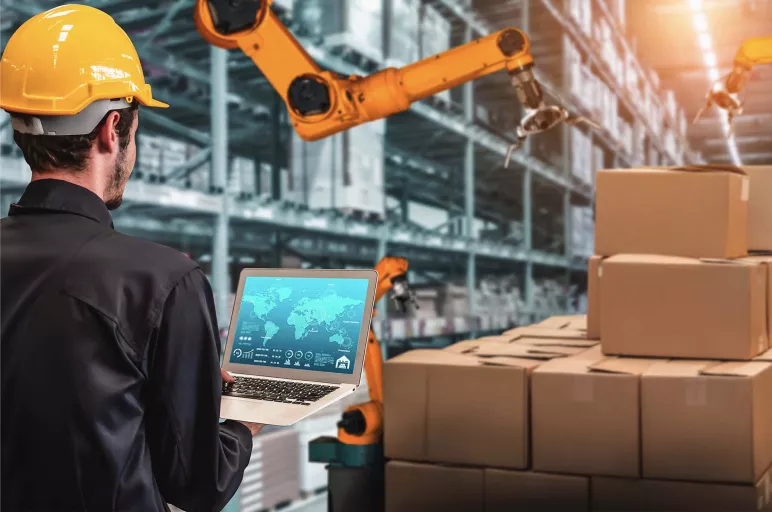
A Guide to Mastering Supply Chain Automation
- Supply chain automation encompasses the use of technology and software to streamline and automate various processes within the supply chain
- Supply chain automation is a transformative force with many benefits, including enhanced efficiency, cost savings, improved customer service, and a positive impact on sustainability
- Emerging trends such as blockchain, edge computing, and advanced analytics are expected to reshape the supply chain landscape further
June 09, 2023 | Supply Chain Software
Supply chain automation has become an essential component for enterprises to optimize their operations, gain a competitive edge, and meet the demands of a rapidly evolving business landscape.
This blog discusses the intricacies of supply chain automation, highlighting its benefits, latest trends, and the imperative of sustainability.
Understanding Supply Chain Automation
Supply chain automation encompasses the use of technology and software to streamline and automate various processes within the supply chain. From inventory management and order processing to logistics and customer service, automation replaces manual tasks, reduces errors, and enhances visibility and control over operations.
Benefits of Supply Chain Automation
The benefits of supply chain automation include:
Enhanced Efficiency
Automating repetitive and time-consuming tasks ensure supply chain professionals can focus on more strategic activities. This increased efficiency improves productivity and reduces risks of human error.
Cost Savings
Automation optimizes processes, leading to cost savings. Accurate demand forecasting prevents stockouts and overstocking, reducing storage costs and missed sales opportunities. Furthermore, automation minimizes waste by optimizing inventory management and production processes.
Improved Customer Service
Automation enables real-time updates for customers, enhancing their experience. Streamlining order processing and expediting tracking lead to faster and more accurate order fulfillment, resulting in higher customer satisfaction and loyalty.
Latest Trends in Supply Chain Automation
Here are some of the latest trends in supply chain automation:
Artificial Intelligence (AI) and Machine Learning (ML)
AI and ML technologies have revolutionized supply chain automation. These technologies can analyze vast amounts of data in a very short period of time, identify patterns, and make predictions. By leveraging AI and ML, enterprises can optimize decision-making, improve forecasting accuracy, and enhance overall supply chain performance.
Robotics and Autonomous Systems
Robotics plays a significant role in automating physical tasks within the supply chain. Autonomous forklifts, warehouse drones, and robotic pickers streamline labor-intensive processes, increasing efficiency and reducing the risk of workplace injuries.
Internet of Things (IoT)
IoT devices, including sensors and RFID tags, collect real-time data throughout the supply chain. This data enables enterprises to monitor inventory levels, track shipments, and identify bottlenecks, facilitating proactive monitoring, decision-making, and optimizing supply chain operations.
Sustainability in Supply Chain Automation
Sustainability has become a paramount concern in supply chain management in recent years. Enterprises continue to seek ways to reduce their environmental impact and embrace sustainable practices. Supply chain automation contributes to sustainability in several key ways:
Energy Efficiency
Automated systems, such as smart warehouses and optimized transportation routes, minimize energy consumption, which in turn help reduce carbon emissions and ecological footprints.
Waste Reduction
Automation helps enterprises minimize waste by improving inventory management, accurately forecasting demand, and optimizing production processes. This reduces overstocking, eliminates excess inventory and minimizes the disposal of unsold products.
Ethical Sourcing
Automated systems enable companies to track and trace products throughout the supply chain, ensuring compliance with ethical sourcing practices. This includes verifying fair trade, responsible manufacturing, and adherence to labor and human rights standards.
The Future of Supply Chain Automation
As technology continues to advance, the future of supply chain automation holds immense potential. Emerging trends such as blockchain, edge computing, and advanced analytics are expected to reshape the supply chain landscape further. Blockchain can help enterprises enhance transparency and traceability, while edge computing can enable real-time data processing at the network edge. Advanced analytics provides deeper insights into supply chain performance, enabling proactive decision-making.
Key Considerations for Implementation of Supply Chain Automation
The successful implementation of supply chain automation requires careful planning and execution. Here are some key considerations:
Technology Integration
Enterprises should evaluate their existing systems and infrastructure to ensure seamless integration with automation technologies. Compatibility and interoperability between different automation solutions are critical for achieving a unified and efficient supply chain.
Workforce Transition
Automation may change the nature of job roles within the supply chain. It is essential to provide adequate training and support to employees to adapt to new technologies and focus on higher-value tasks that require human expertise.
Data Security
With increased automation comes an increased reliance on data. Organizations must prioritize data security and implement robust measures to protect sensitive information from cyber threats and unauthorized access.
Continuous Improvement
Supply chain automation is an ongoing process. Enterprises should continually monitor performance, gather feedback, and identify areas for improvement. This may involve fine-tuning automation algorithms, upgrading technology, or incorporating new innovations as they emerge.
Collaboration and Partnerships
To fully leverage the benefits of automation, organizations should collaborate with technology vendors, industry experts, and supply chain partners. Building strong partnerships can provide access to specialized knowledge, shared resources, and best practices, further enhancing the effectiveness of automation initiatives.
Conclusion
Supply chain automation is a transformative force. It’s revolutionizing the way businesses operate, offering numerous benefits, including enhanced efficiency, cost savings, improved customer service, and a positive impact on sustainability. By embracing the latest trends in AI, robotics, and IoT, enterprises can optimize their supply chain processes and stay competitive in a rapidly evolving business environment.
Successful implementation of automation would however require careful planning, technology integration, workforce transition, data security, continuous improvement, and collaboration. By navigating these considerations with expertise and foresight, businesses can unlock the full potential of supply chain automation and drive long-term success in their operations.




